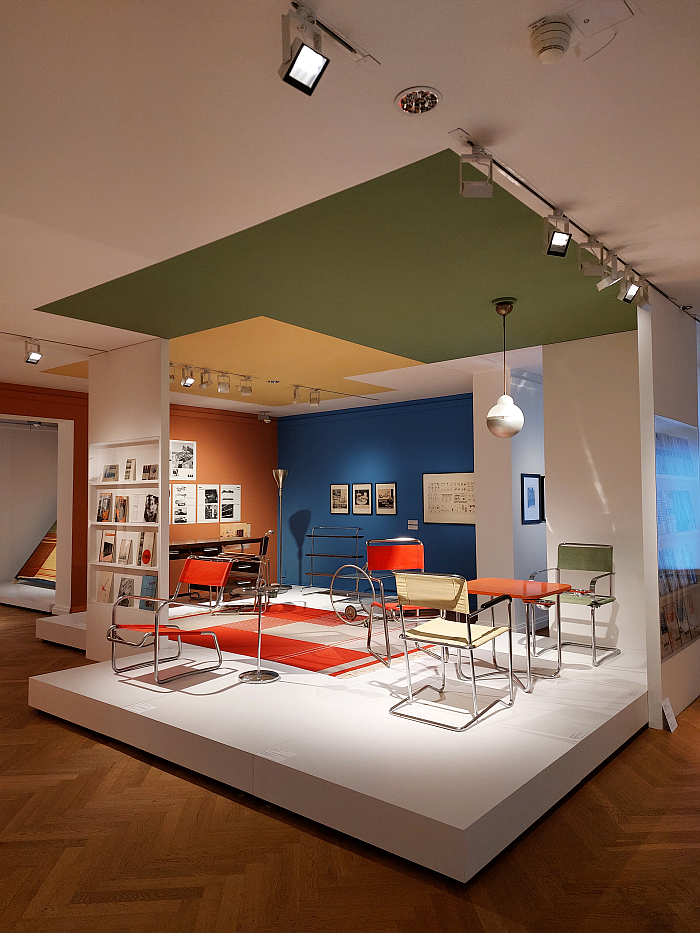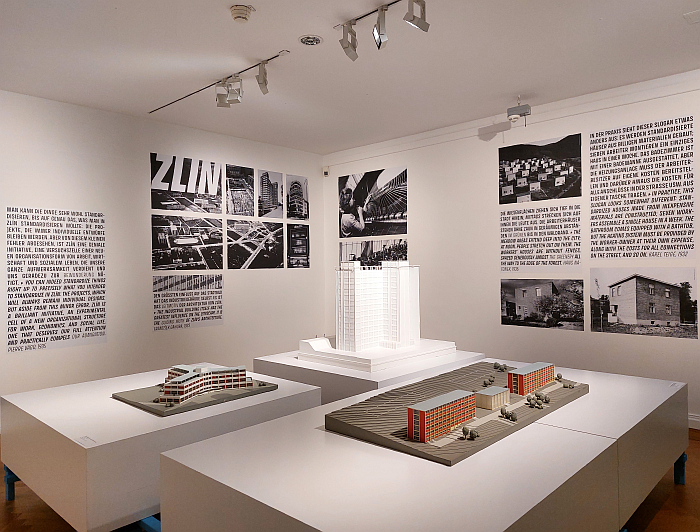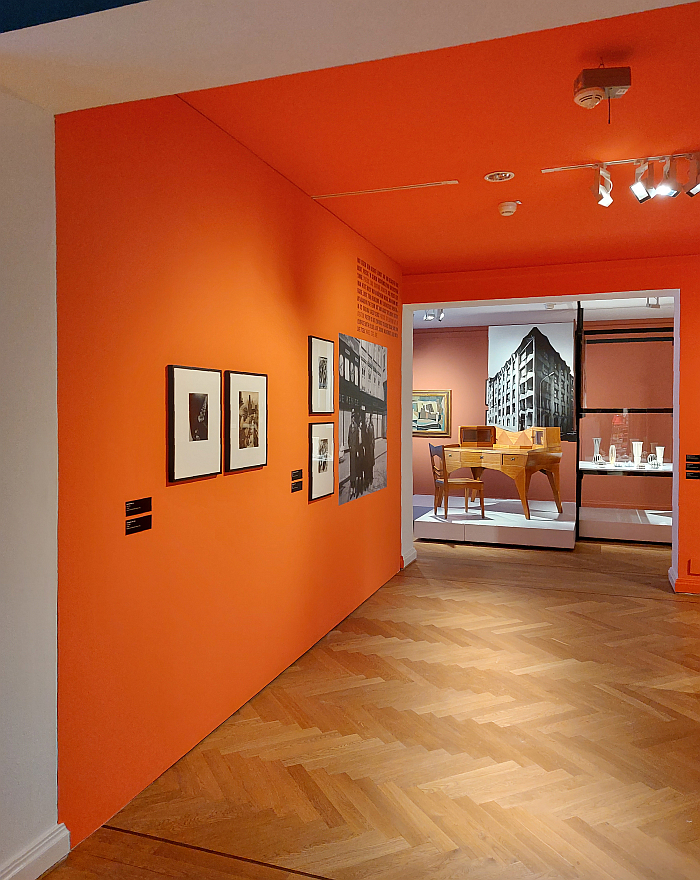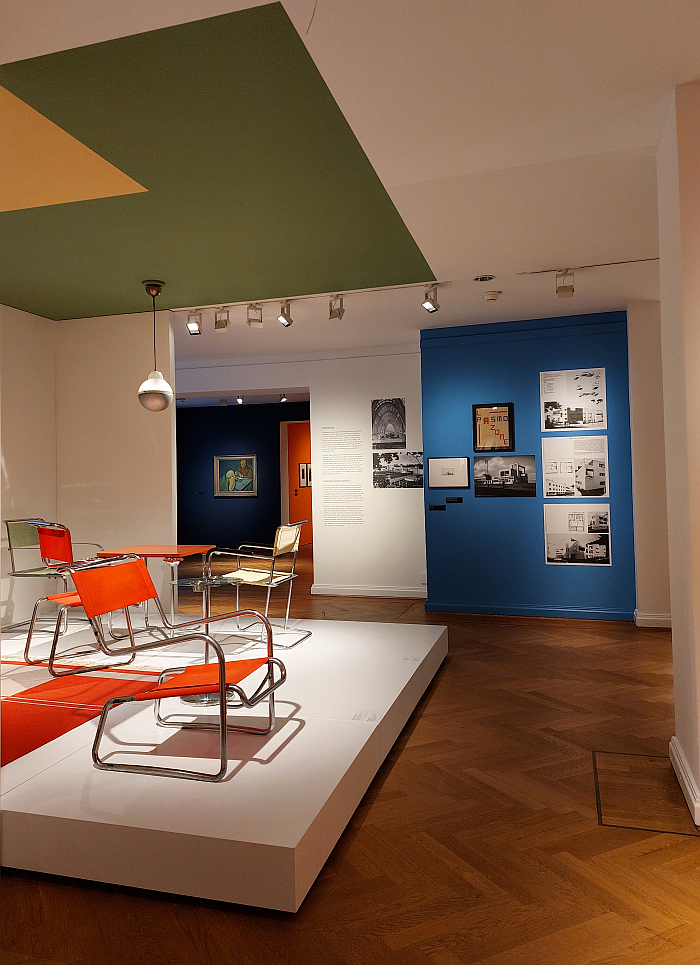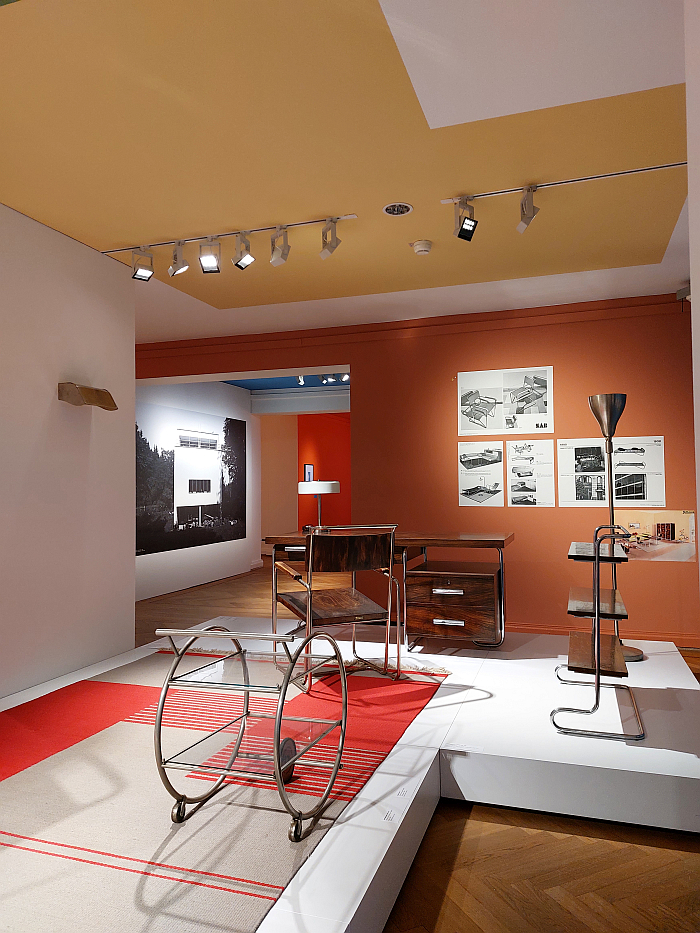Hej rup! The Czech Avant-Garde at the Bröhan Museum, Berlin
There is an argument to be made that popular understandings of, and the popular presentation of, inter-War European avant-garde architecture and design tend to focus on Germany and Russia, and on Functionalism, popular foci that tend to cause us all to forget that the inter-War European avant-Garde was a homogenous mix of positions and, and as with the Art Nouveau before it, an international moment defined by its variety of regional dialects.
With the exhibition Hej rup! The Czech Avant-Garde the Bröhan Museum, Berlin, provide for an introductory course in inter-War Czechoslovakian…….
As an exhibition Hej rup! The Czech Avant-Garde opens, conceptually, with the purchase by the Bröhan Museum of an assortment of steel tube furniture realised in the 1930s in the, then, Czechoslovakia, a collection the museum very pleasingly decided against simply placing in their permanent exhibition space and instead sought to develop a platform, an exhibition, via which to present them in context of the period and the movements in which they arose, the context of their genesis, rather than the (relative) contextlessness of a plinth in the permanent exhibition space. Hej rup! The Czech Avant-Garde is that platform, that exhibition.
As an exhibition Hej rup! The Czech Avant-Garde opens, chronologically, (essentially) in 1918 with the creation of Czechoslovakia, one of a number of new nations to appear in Europe following the War of 1914-1918 and the associated disintegration of the once dominant and defining European Empires; the exhibition title Hej rup! translates as, can be translated as, ‘Let’s Go!’, ‘Let’s Roll!’, ‘Heave Ho!’, etc and thus very much embodies the spirit, or perhaps more accurately a spirit, of the age of transformation and rebuilding in the new Czechoslovakia. And, as one learns, a spirit amongst the Czechoslovakian creatives of the age.
As an exhibition Hej rup! The Czech Avant-Garde opens, in the Bröhan Museum, with Cubism, and thus not only slightly before the formal creation of Czechoslovakia but with, arguably, the most popularly known Czechoslovakian expression of inter-War creativity, and the most informative example of a local dialect of an international language: that way in Czechoslovakia the positions of Pablo Picasso, Georges Braque et al were translated from artistic, decorative expressions into functional, utilitarian expressions, including as furniture and architecture, such as the 1913 desk by Josef Gočár, the 1912 upholstered armchairs by Pavel Janák and Vlastislav Hofman or the varied construction projects by the likes of, for example, Josef Chochol or Jiří Kroha that greet one in the first chapter of Hej rup! alongside ceramics from Artěl, those inevitable but ever welcome and engaging components of discussions on inter-War Czechoslovakian creativity. And also works of art by the likes of, and amongst many others, Václav Špála, Josef Čapek, or Jan Štursa whose 1916/17 sculpture Raněný, Wounded, not only so poetically, and timeously, underscores the personal and communal, individual and social, trauma of war, but also reminds that the 1914-1918 War which brought about the creation of Czechoslovakia, also, effectively, marked the end of Cubism as an international movement.
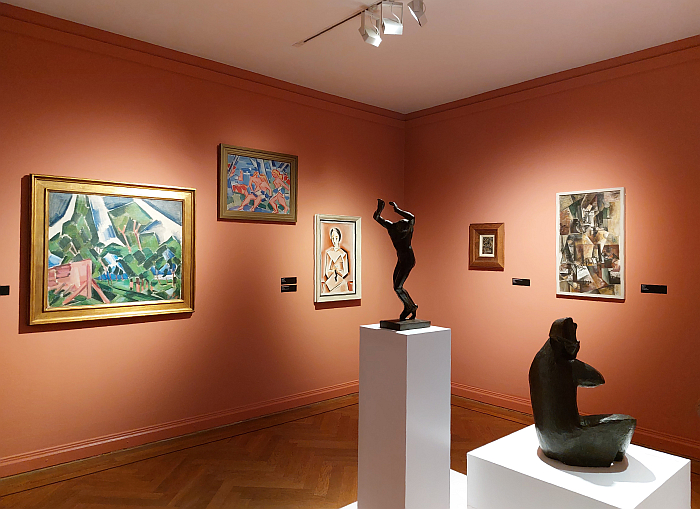
Works of Cubist art, including in the middle Jan Štursa’s 1916/17 sculpture Raněný, Wounded, as seen at Hej rup! The Czech Avant-Garde, Bröhan Museum, Berlin
A discourse with Cubism in (the future) Czechoslovakia, a discourse with Cubism that saw Czechoslovakian creatives develop new appreciations of what Cubism is, could be, should be, that, inarguably, very naturally and self-evidently, placed the Czechoslovakian avant-garde in contact with a wide variety of post-Cubist movements, or more accurately, in contact with movements that followed on from Cubism, and from the experiences of, and political and economic changes enforced by, the 1914-1918 War, including Surrealism, a moment in European cultural (hi)story that as with Cubism traces its origins back to Paris and which as Hej rup! helps elucidate was one taken up in Czechoslovakia with an interest and intensity to match that of Cubism. Not least by Jindřich Štyrský and Toyen whose works form the core of the Surrealist chapter in Hej rup!, alongside works by, for example, František Janoušek, Emil Filla or Miloš Koreček whose Fokalk process, a methodology that involves burning/heating the gelatine of photographic plates before creating images from the damaged areas, is one of the more singularly Czechoslovakian articulations of Surrealist positions; and a brief discussion on Surrealism in Czechoslovakia which allow access to artists and creatives you are possibly unaware of, but certainly should be aware of, and thereby access to a more probable understanding of the development of Surrealism. And also allows one to better appreciate the development of the Czechoslovakian dialect of inter-War creativity.
Not that creativity in Czechoslovakia was just Parisian vocabularies articulated in a local dialect, it wasn’t, for as Hej rup! elegantly elucidates inter-War creativity in Czechoslovakia was also Poetism, a position developed by Karel Teige, an omnipresent character in, and driving force amongst, the inter-War Czechoslovakian avant-garde and thus a Karel Teige omnipresent in Hej rup!; and a Poetism developed in two manifestos by Teige from 1924 and 1928 and, and summarising more than is prudent, if necessary on account of restrictions of time and space, a Poetism arising in the position that post-Cubism art should cease to be a profession amongst artists and become a daily activity for all, and which represented a deliberate return to a more faithful, for Teige, understanding of the Ancient Greek term/position poíēsis, of freeing poíēsis from its associations with ‘poetry’, with written forms of expression, and making poíēsis the foundation of all human activity, of human life. And a Poetism that, as Hej rup! discusses, in its philosophical and programmatic foundation is one of the key definers of inter-War creativity in Czechoslovakia, one of the main things other avant-gardes didn’t have; one of the primary identifying grammatic features of inter-War creativity in Czechoslovakia. And the fact the majority of you will be reading ‘Poetism’, and ‘Karel Teige’, for the first time underscoring how much we all still have to learn about inter-War Czechoslovakian creativity.
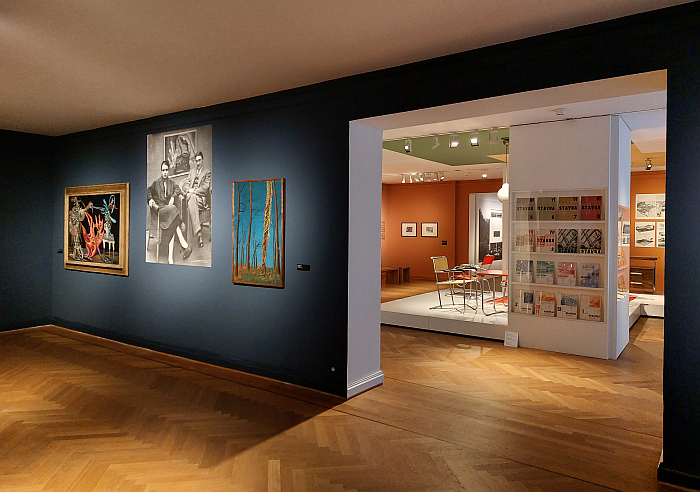
Works by, and a photo of, Jindřich Štyrský and Toyen, as seen at Hej rup! The Czech Avant-Garde, Bröhan Museum, Berlin
And a introduction to Poetism, and Karel Teige, that is staged in Hej rup! alongside an evocation of the Odeon bookshop and publishing house in Prague, an important location of and for the avant-garde, and also by examples of literature associated with avant-garde positions, and published by Odeon, including, for example, the magazines Výtvarné snahy, Weekend, or Revue Devětsilu, ReD, the official publication of the collective Devětsil of which Teige was a defining member and who were so important in the early years of Czechoslovakia, or books by the likes of Egon Erwin Kisch, Zdeněk Rossmann or Vítězslav Nezval whose 1935 anthology Žena v množném čísle, Woman in the Plural, is one of several to feature a cover design by Karel Teige. And a collection of books that also features Karel Čapek’s novel/essay R.U.R., Rossumovi Univerzální Roboti, that 1920s tale of a Utopian future with such strong parallels to the future promised to us all in the 2020s, but which went so very, very badly wrong, unlike our glorious future, obviously. And which, as previously noted in these dispatches, in its German-language stage premier in 1923 marked, if one so will, the international breakthrough for the Ukrainian designer and interior architect Friedrich Kiesler, another all to rarely heard voice and articulation of the inter-War avant-garde. And a R.U.R. to which we shall shortly return.
Whereas the earliest chapters of Hej rup! are staged thematically, focus on the sort of ‘-isms’ the Poetists sought to guide us all away from, the later chapters focus more on individual creative genres including theatre, interior design, product design, photography, whereby unless we missed them there are no works by the Prague born Lucia Moholy which could have provided for a neat juxtaposition and extension of some of the discussions initiated by the Bröhan Museum’s 2022 exhibition Lucia Moholy – The Image of Modernity, or architecture, including a very informative, thought-provoking, and satisfying, juxtaposition of Mies van der Rohe [and Lilly Reich’s] Villa Tugendhat in Brno as out-of-control decadence with a Karel Teige’s 1932 book Nejmensí byt, The Smallest Apartment, as a contribution to the debate of the period on the provision of affordable, decent, hygienic accommodation for all, a debate a Mies van der Rohe [and a Lilly Reich] only very briefly and sporadically concerned themselves with. Or architecture as urban planning in context of the development from 1925 of the city of Zlin as, in effect, a workers’ town for the Bat’a shoe factory, a town developed in context of the rational, industrial, optimised positions of the Functionalists, a town based on the contemporaneous garden city principles and in which high-rise apartment blocks were developed and built before they became such a central feature of housing provision in Czechoslovakia, and a workers’ town which embodies the Bat’a owner’s hope that if his workers lived a communal existence thanks to the generosity of the employer, thanks to the provision by the employer of not only work but of social and cultural activities, he could provide a successful and dominant alternative to communism. A position that we’d very much like to know a William Morris’s views on. We suspect he’d disagree. And a Zlin project that is just one of a great many projects on show in Hej rup! that elucidate how much there is to learn about and from inter-War Czechoslovakia.
Or furniture design, for all furniture designed in context of the steel tubing of the period, that furniture with which Hej rup! conceptually began, and whose setting in the midst of the myriad other positions, themes and discussion of Hej rup!, in the midst of the inter-dependencies of the period, helps underscore the inter-dependencies of any period, that any given cultural expression never occurs in isolation but always in context of prevailing realities and in discourse with other forms of cultural expression.
Thereby allowing Hej rup! to exist not only as introductory course in inter-War Czechoslovakian, but also as an introduction to linguistics and the development of language. And thus also as an introduction to the Czechoslovakian contribution to the development of architectural and design linguistics in 20th century Europe.
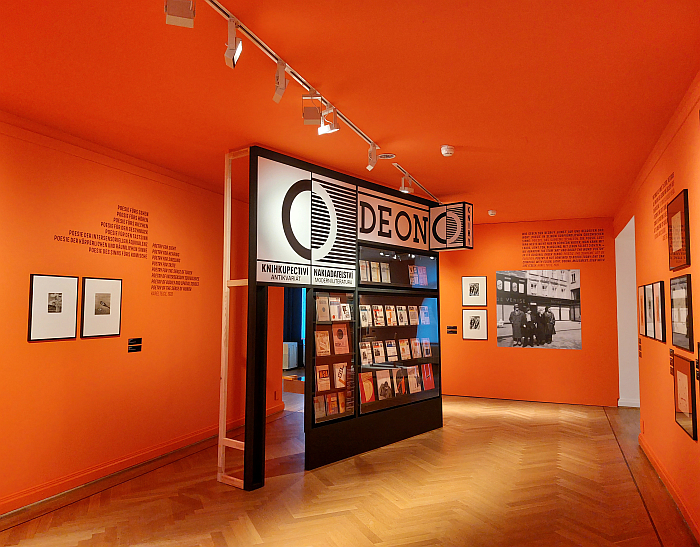
A discussion on the Odeon publishing house/bookshop and Poetism, as seen at Hej rup! The Czech Avant-Garde, Bröhan Museum, Berlin
Much as Hej rup! opens, essentially, with the creation of Czechoslovakia, it, essentially, ends with the, effective, end of Czechoslovakia in the form in which it had been created those few short years previous, and with such high hopes: a demise that begins with the annexation by Germany of the so-called Sudetenland areas of Czechoslovakia from 1938 and is consummated by the Communist coup of 1948, a coup Zlin couldn’t stop; and a period which, as with elsewhere in Europe, saw the creative avant-garde not just limited in their freedoms but increasingly disperse and isolated. And a new reality following the 1948 Communist coup which as the curators note caused all manner of existential problems for many of the creatives who had long envisaged a socialist or a communist state, a Utopia akin to that promised by Čapek in R.U.R., before being faced with the realities of a Stalinist Dystopia. By that Dystopia Čapek’s Utopia became. And which William Morris probably wouldn’t have predicted was going to happen. And thus a moment in European (hi)story which helps elucidate one of the problems of Utopias of all hues, even our flawless AI based, smart, future. Or can elucidate one of the problems if we want to listen.
And a period of Soviet domination of Czechoslovakia and the contemporaneous poisoning of the inner-European discourse by both sides of the Iron Curtain, that inner-European discourse which had been so fruitful in developing European society before it was poisoned, an apposite reminder of what cooperation can bring as opposed to borders, which meant that, and as with elsewhere in the eastern half of Europe, many of the works, positions and protagonists slipped into a relative anonymity. Also through the all-enveloping, impervious shadows cast post-War by Germany and Russia. A relative anonymity which, as discussed in context of Retrotopia. Design for Socialist Spaces at the Kunstgewerbemuseum, Berlin, combined with a general rejection in western Europe of eastern European design, has led to the relatively poor appreciations today of not only the (hi)story of design in nations such as the former Czechoslovakia, including popular appreciations of how the relative brevity of the Czechoslovakian avant-garde influenced and informed post-War Czechoslovakian designers, for it invariably did, even as reaction against it, but also leads to the relatively poor appreciations of contemporary design in the lands of the former Czechoslovakia. Means fewer of us look east than could, and should.
Hej rup! is a reminder of why that is a problem and an invitation to begin to rectify things.
An invitation to learn a little Czechoslovakian and thereby aid and support your reading of design (hi)story.
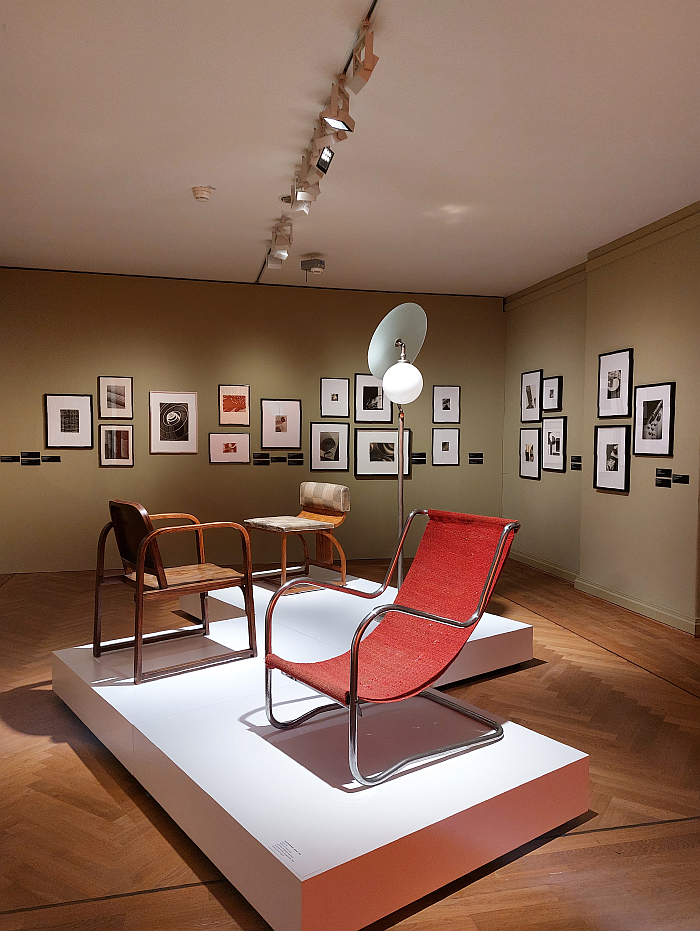
A presentation of photography, and furniture and lighting by Jiří Kroha, Ladislav Žák and an in-house design from Tatra Martin, as seen at Hej rup! The Czech Avant-Garde, Bröhan Museum, Berlin
For all that Hej rup! is a review of creativity in Czechoslovakia in the first decades of the 20th century it is very much primarily a review of Czechoslovakia creativity; as the curators note the Czech part of the nation was much more industrial than the agrarian Slovakian part, and thus most of the cultural avant-garde were at home in Prague and Brno (and Paris). Which isn’t to say CzechoSlovakia doesn’t feature, it does, when all be it briefly, and in the forms of, for example, a nickel silver ashtray and cake slice by Bohumil Južnič for, then, Dolné Hámre based Sandrik, a cutlery producer whose (hi)story stretches back to the late 19th century, or a 1930s tubular steel lounge chair and bentwood armchair produced by the Pravenec based manufacturer Tatra Martin: a bentwood armchair whose relative quadraticness belies its construction principle; a bentwood armchair that helps elucidate how formal expressions evolve over time, you can see where it came from and where its going; and a bentwood armchair that reminds that a great deal of the (hi)story of Thonet and Michael Thonet was played out in the future Czechoslovakia, and thus that Thonet must be considered a component of Czechoslovakian furniture design (hi)story. Which thus helps remind us all that considerations on whether a particular project was developed in the contemporary Czech Republic or Slovakia is one from today’s perspective, back in the period under consideration it wasn’t Czech or Slovakia but Czech-a-Slovakia.
And works which as with ‘Karel Teige’ and ‘Poetism’ you are probably unaware of, and which underscore that as much as being an invitation to learn a few nuggets of Czechoslovakian Hej rup! is also an opportunity to get to know a lot of works, and a lot of protagonists, you don’t know, but need to know.
For our part were particularly taken by, and amongst many others, and apart from the aforementioned Tatra Martin bentwood chair and tubular steel lounge chair, the aforementioned 1912 Cubist upholstered chair by Pavel Janák realised by Prazske umelecke dilny, PUD, a institution who, if we’ve understood correctly, were similar to the Vienna or Munich Werkstätten and thus formed part of the path from Art Nouveau to Functionalism, a work whose backrest represents function as decoration and decoration as function and thus embodies an interesting moment in developments of objects of daily use, and a reminder of what Czechoslovakian Cubism brought to creative discourses; but for all a work whose rear legs are essentially straight while the front legs feature a small forward moving knick. Which isn’t normal, isn’t a regularly encountered construction, and one that looks wrong, very wrong, but one presumes functions. Or by the 1930 photomontage na bauhause, am bauhaus by Karel Teige that features prominently the musicians of the Bauhauskapelle, that oft so overlooked but so important Bauhaus institution, and thus an informative reminder that even in context of those moments in architecture and design (hi)story that receive the most popular attention, our focus is restricted and static. Or by a late 1920s chair and lamp by Jiří Kroha both of which not are only thoroughly engaging works that could be released tomorrow with a freshness the contemporary market wouldn’t know how to absorb without resorting to cliché, but which also predict the incongruous juxtapositioning of geometric forms and idiosyncratic resolutions of the form function relationship of the 1970s and 80s. Which, yes, is the first time we’ve avoided using the term ‘Postmodern’ since Everything at Once: Postmodernity, 1967–1992 at the Bundeskunsthalle, Bonn, and, no, we didn’t do it very well did we. We must work on that.
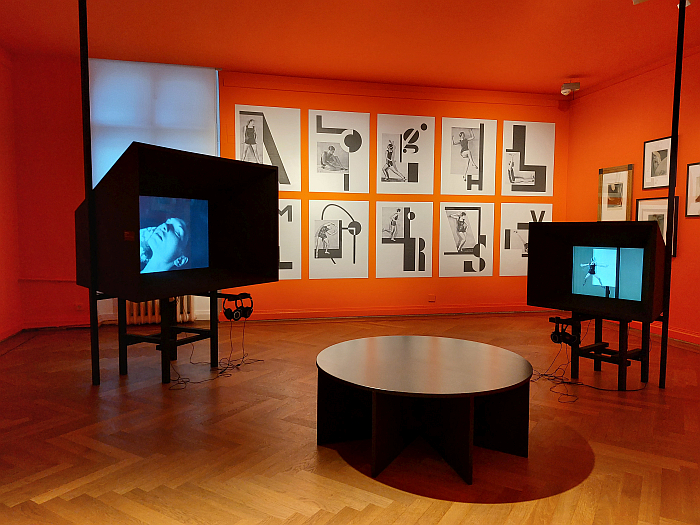
A discussion on Czechoslovakian film and theatre and typography, as seen at Hej rup! The Czech Avant-Garde, Bröhan Museum, Berlin
And we were also very taken by the myriad of steel tube furniture on show, much or all of which were the starting points to Hej rup! We sadly have neither the time nor space for an exhaustive discussion on the works, but will note here that the scope and scale of the presentation helps underscore why we need to move away from classifying steel tube furniture as ‘Bauhaus’ furniture, cause it isn’t, it’s inter-War furniture, and also the need for a reappraisal of the (hi)story of steel tube furniture beyond the established narrative; and will also note the ashtrays integrated into the tables, not only a thoroughly joyous reminder of the age in which they were created and of the relationships that should exist between furniture and age, but also an interesting take on the function of a table; and will note the construction focus of the majority of the chairs, as works they accept steel tube furniture is a thing, and then decide to have fun with the hows, something deliciously demonstrated in two cantilever chairs by Karel E. Ort for Prague based Hynek Gottwald; and also note the folded sheet steel armrests of the 525 chair by Josef Havlíček for S.R.O. Prague which both reference and seem to mock the leather strap armrests of a Kaare Klint, while also making a strong case for metal as the better leather. And a 525 cantilever from 1932 whose quadratic base reminds that it was in June 1932 that Mart Stam received the artistic copyright for the cubic cantilever, thus effectively forcing all other designers and manufactures to be more creative in their steel tube cantilever forming. And the associated question one must ask oneself in Hej rup! as to if the aforementioned 1931 tubular steel lounge chair by Ladislav Žák for Tatra Martin is covered by Stam’s patent? We’d argue not, although it is an unsupported resilient sitting solution. But is it cubic? And is it a cantilever?
And having viewed and studied such works, having worked your way through Hej rup!‘s chapters, having grasped a little elementary inter-War Czechoslovakian, having begun to overcome your irrational fear of unfamiliar diacritics, you can then take your freshly acquired language skills downstairs to the Bröhan Museum’s permanent exhibition space and converse with the works on show there, reflect on and consider the familiar (hi)story of inter-War creativity in your basic Czechoslovakian rather than the more normal, better practised, German or Russian; can begin to view the (hi)story of design in Europe in context of Czechoslovakia, rather than viewing Czechoslovakia in context of the rest of Europe.
Which is just one of the many satisfying aspects of Hej rup!
An intelligently designed and well paced exhibtion which for all its relative brevity, a necessary brevity on account of the number of themes to be discussed, not only allows one to approach a better appreciation of the developments in creativity, and society, in Czechoslovakia in the first three decades of the 20th century, and to approach a more probable understanding of the networks and discourses which helped drive creativity in Czechoslovakia, and Europe, in that period, Hej rup! also reminds you why exhibitions such as it are important.
A reminder of the urgent need for us all to expand our vision beyond the established perspectives of architecture and design (hi)story, to accept the limitations and problems of our established, western focussed, summarisation of design (hi)story and to seek to expand the narrative. A reminder that the adding to the cake demanded by Vera Sacchetti and Matylda Krzykowski at the Kunstgewerbemuseum Dresden isn’t and shouldn’t be in context of gender alone, but in a myriad contexts.
A reminder that Hej rup! delivers without preaching or patronising, but through the quiet manner in which it presents itself. Yet a reminder which is very much stressed.
But for all Hej rup! provides the impetus to develop your inter-War Czechoslovakian beyond that level an introductory course can bring you to, and to seek a higher fluency in inter-War Czechoslovakian…….
…….what you waiting for? Hej rup!!!!
Hej rup! The Czech Avant-Garde is scheduled to run at the Bröhan Museum, Schlossstraße 1a, 14059 Berlin until Sunday March 3rd.
In addition a, German-only, catalogue, an, if one so will, advanced level text-book, featuring essays on several of the themes covered in the exhibition is available.
And until Sunday January 21st you can also view Haël. Margarete Heymann-Loebenstein and her workshops for decorative ceramics 1923-1934, another all too rarely viewed perspective on inter-War creativity.
Full details, including information on the accompanying fringe programme, can be found at www.broehan-museum.de
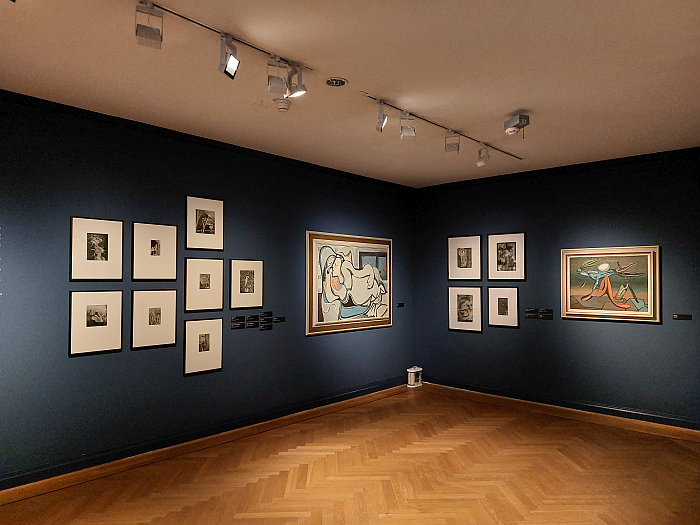
Examples of Czechoslovakian Surrealist art, as seen at Hej rup! The Czech Avant-Garde, Bröhan Museum, Berlin
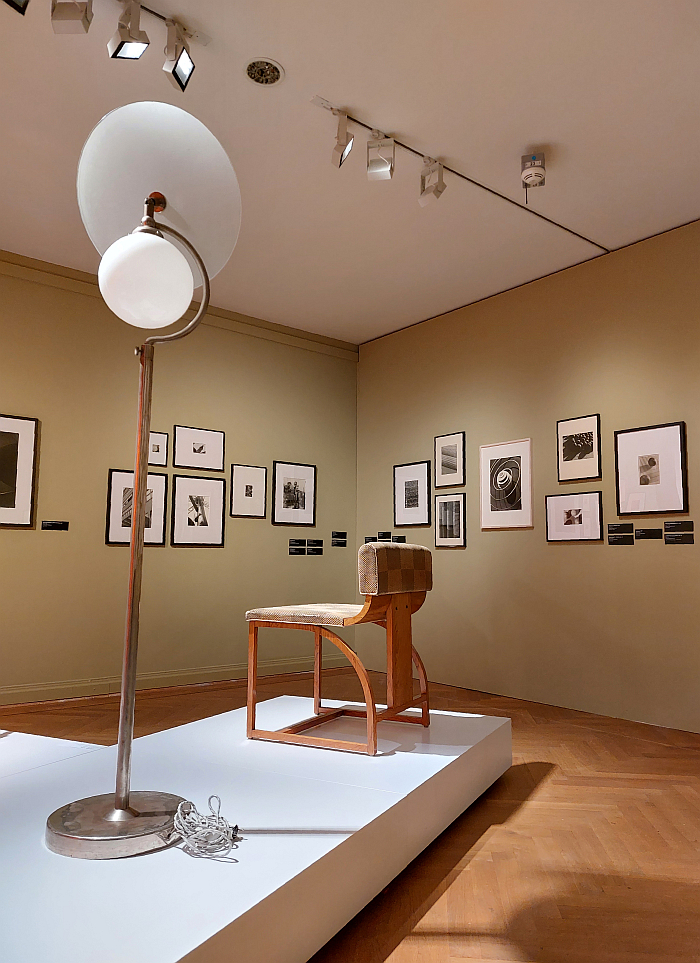
A late 1920s chair and lamp by Jiří Kroha, as seen at Hej rup! The Czech Avant-Garde, Bröhan Museum, Berlin
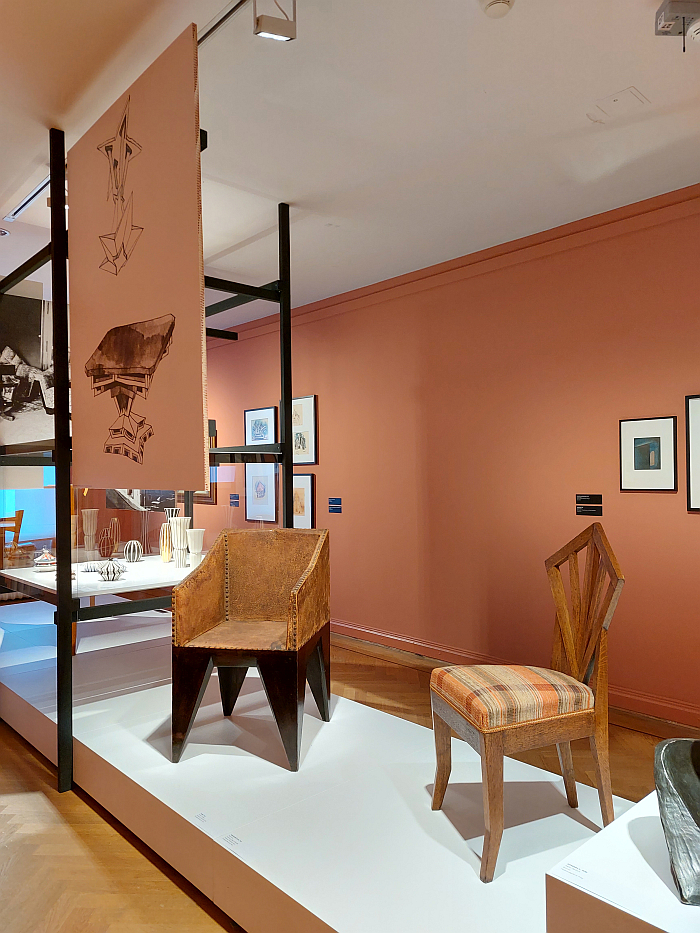
Chairs by Pavel Janák and Vlastislav Hofman, as seen at Hej rup! The Czech Avant-Garde, Bröhan Museum, Berlin
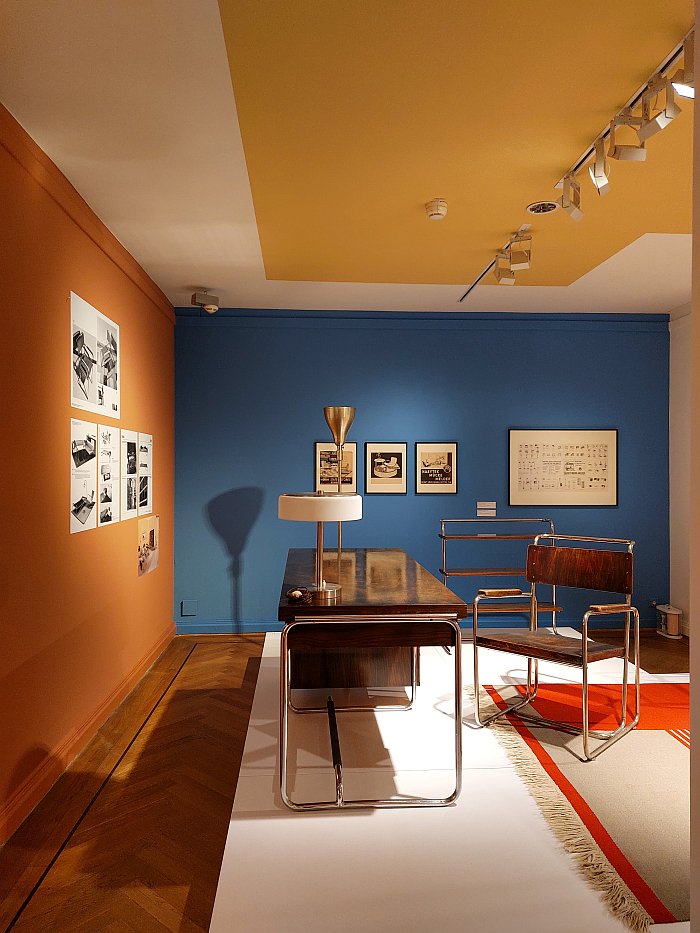
A chair by Karel E. Ort for, and an in-house desk from, Hynek Gottwald, alongside a lamp by Jaroslav Anýž and numerous steelt ub furniture manufacturers catalogues, as seen at Hej rup! The Czech Avant-Garde, Bröhan Museum, Berlin
Tagged with: Berlin, Bröhan Museum, Czech Republic, Czechoslovakia, Hej rup!, Karel Teige, Poetism, Slovakia, steel tube, The Czech Avant-Garde
